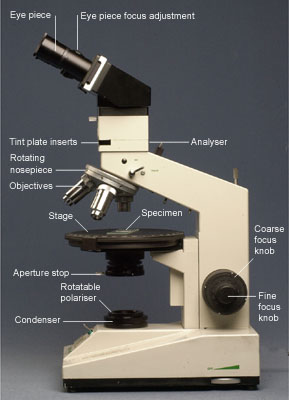
The transmitted light
microscope. (Click on image to view larger version.)
- Place the mounted
specimen on the stage. The area to be viewed should be
positioned approximately beneath the objective lens.
- Switch on the
illumination, starting at a low power setting and
gradually increase until the desired light level is
reached. This can best be judged by increasing the power
until a clear spot of light is seen on the specimen
surface.
- Use the lowest
magnification objective lens to coarsely focus the
microscope. Without looking down the microscope, lower
the objective lens close to the specimen surface then
use the coarse focus knob to slowly raise it until the
circle of light on the specimen appears reasonably
sharp.
Be careful not
to 'crash' the lens into the specimen when focusing -
ALWAYS focus coarsely by pulling the lens AWAY from the
sample.
The following
instructions assume the user is working with a binocular
microscope - one with two eyepieces.
- Adjust the eyepieces
so that they are the right distance apart. This is done
by carefully sliding them apart or closer together so
that a single image can be seen comfortably.
- Looking through the
eyepieces, use the fine focus knob to bring the image
into sharp focus.
- The eyepieces should
now be further adjusted - one of them will focus
separately, as many people have slightly different focus
in each eye. The image should be brought into focus in
the non adjustable eyepiece first using the fine focus
knob, and then the other eyepiece rotated so that it is
also in focus.
- If a higher
magnification is required the appropriate lens can be
moved into place, and the image can be refocused using
the fine focus knob.
If focus is lost while at a
high magnification, do not adjust the focus using
the coarse focus knob, as it would be easy to crash the lens
into the specimen. Change the objective lens to a lower
magnification and then re-focus as described previously. The
magnification can be increased again once the specimen is
back in focus.
Further tips for
transmission microscopy
When using a transmission
microscope, it is useful to centre the stage below the lens.
This is because it is often necessary to rotate the stage in
order to observe changes that occur in polarised light. If
the stage is not properly centred, it will be difficult to
observe a particular area of the specimen at different
angles of rotation.
The stage can be centred by
adjusting small knobs at the side of the stage which can
move it from side to side and towards and away from the
microscope. It should not be necessary to make large
adjustments to these knobs.
 DoITPoMS Teaching and Learning Packages
DoITPoMS Teaching and Learning Packages